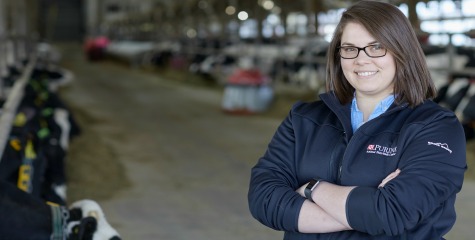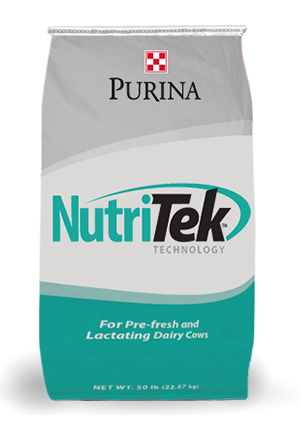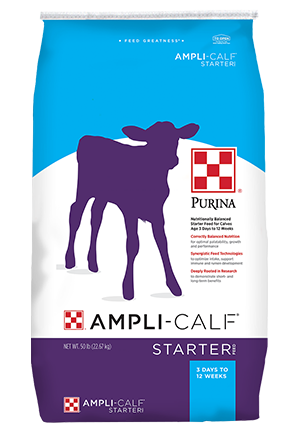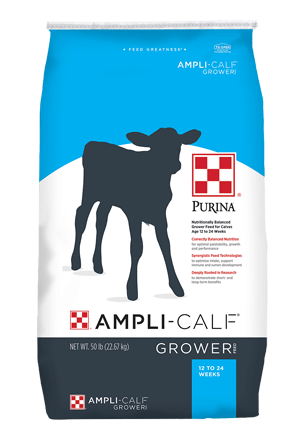
Setting the Stage for Long-Term Success for Dairy-Beef Cross Calves
Animal : Calf
With the opportunity to capitalize on the record low native beef herd numbers and the growing demand for high-quality beef, dairy-beef crossbred cattle producers can benefit from taking a second look at their early-life calf nutrition program.
 Many of the factors that determine long-term growth and performance of cattle are determined during the neonatal period. During this pre-weaning stage, calves are going through many important development processes, and this may be the best opportunity for producers to positively impact a calf’s future growth and performance.
Many of the factors that determine long-term growth and performance of cattle are determined during the neonatal period. During this pre-weaning stage, calves are going through many important development processes, and this may be the best opportunity for producers to positively impact a calf’s future growth and performance.
Due to the higher feed efficiency associated with native beef breeds, there is a notion that crossbreds can be fed less total milk replacer than purebred Holstein calves. While they do have better relative feed efficiency, implementing restrictive feeding can lead to long-term effects such as increased health risks and lower production potential. Producers who focus on a nutrition program that supports efficient weight gain and muscle growth can see a more positive outcome.
The first three months of life are critical in the maturation of the gut.1 During this time, the physical barrier and structure of the rumen and intestine are developing as well as the immune system. Simultaneously, the microbiome is established and undergoes maturation, which plays a vital role in the long-term health of the animal. Early life intervention may be an effective way to support the gut microbiota in adults.
Muscle development
Neonatal nutrition has been shown to influence muscle growth and protein accumulation. Animals are born with a set amount of muscle cells and can’t produce more of them, so fetal development is the most critical time period to support total muscle cells in animals. Post-natal skeletal muscle growth is dependent on satellite cells that allow the muscle cells to continue to grow larger. During the early neonatal phase, satellite cells are rapidly produced and go through key developmental stages that allow muscle cells to function properly as the animal grows. As the calf matures, the ability to produce these cells is drastically reduced.
Adipocyte development
Early life is also critical for adipocyte – cells that store fat – development. It is important to develop the population of adipocytes early as these are the cells that will fill with lipids to become marbling as the animal gets closer to maturity. As with muscle cells, the fetal stage is the best opportunity to impact adipocyte numbers, but the opportunity to have an impact on marbling is still high during the first few months of an animal's life and decreases as animals get older.2 Although there is limited research on the impact of very early-life nutrition on marbling development, nutritional interventions in calves have been successful in impacting carcass quality grade.3
To better understand the performance potential of dairy-beef cross calves, researchers compared a high plane of nutrition to a commercial (control) plane of nutrition. In this study, 106 dairy-beef cross calves, across two studies, were reared on either a high plane of nutrition with 2.5 lbs. of milk replacer that contained 26% protein and 20% fat per day with a 22% protein starter or a commercial plane of nutrition with 1.5 lbs. of milk replacer that contained 22% protein and 20% fat per day with an 18% protein standard pelleted starter. Both groups of calves were weaned at 49 days and fed these different programs through 84 days. Calves were then shipped to Oklahoma State University and all calves were fed the same receiving, growing and finishing rations until harvest.
The findings from the trials show that early-life nutrition has a significant impact on the growth and performance of a calf during the pre- and post-weaning phases, but also may have long-term benefits. When comparing a commercial plane of nutrition to a high plane of nutrition, as seen in Table 1, more calves fed the high plane of nutrition in the pre-weaning phase successfully made it to harvest and an increased number of animals graded choice over select when compared to calves fed a commercial plane of nutrition.
Raising dairy-beef cross calves is a value-added production strategy that is on the rise with incredible momentum. By implementing a high plane of nutrition program, producers can set the stage for long-term growth and performance of their calves and improve their bottom line potential.
To learn more, talk with your Purina representative or visit purinamills.com/dairy-beef today.
©2023 Purina Animal Nutrition LLC. All rights reserved.
References
1 Moeser, A. J., C. S. Pohl, and M. Rajput. 2017. Weaning stress and gastrointestinal barrier development: Implications for lifelong gut health in pigs. Anim. Nutr. 3:313-321. http://dx.doi.org/10.1016/j.aninu.2017.06.003.
2 Du, M., J. Tong, J. Zhao, K. R. Underwood, M. Zhu, S. P. Ford, and P. W. Nathanielsz. 2010. Fetal programming of skeletal muscle development in ruminant animals. J. Anim. Sci. 88:E51-E60. doi: 10.2527/jas.2009-2311.
3 Harris, C. L., B. Wang, J. M. Deavila, J. R. Busboom, M. Maquivar, S. M. Parish, B. McCann, M. L. Nelson and M. Du. 2018. Vitamin A administration at birth promotes calf growth and intramuscular fat development in Angus beef cattle. 9:55. https://doi.org/10.1186/s40104-018-0268-7.
 Many of the factors that determine long-term growth and performance of cattle are determined during the neonatal period. During this pre-weaning stage, calves are going through many important development processes, and this may be the best opportunity for producers to positively impact a calf’s future growth and performance.
Many of the factors that determine long-term growth and performance of cattle are determined during the neonatal period. During this pre-weaning stage, calves are going through many important development processes, and this may be the best opportunity for producers to positively impact a calf’s future growth and performance.Due to the higher feed efficiency associated with native beef breeds, there is a notion that crossbreds can be fed less total milk replacer than purebred Holstein calves. While they do have better relative feed efficiency, implementing restrictive feeding can lead to long-term effects such as increased health risks and lower production potential. Producers who focus on a nutrition program that supports efficient weight gain and muscle growth can see a more positive outcome.
The importance of early life
Gut health and immune system developmentThe first three months of life are critical in the maturation of the gut.1 During this time, the physical barrier and structure of the rumen and intestine are developing as well as the immune system. Simultaneously, the microbiome is established and undergoes maturation, which plays a vital role in the long-term health of the animal. Early life intervention may be an effective way to support the gut microbiota in adults.
Muscle development
Neonatal nutrition has been shown to influence muscle growth and protein accumulation. Animals are born with a set amount of muscle cells and can’t produce more of them, so fetal development is the most critical time period to support total muscle cells in animals. Post-natal skeletal muscle growth is dependent on satellite cells that allow the muscle cells to continue to grow larger. During the early neonatal phase, satellite cells are rapidly produced and go through key developmental stages that allow muscle cells to function properly as the animal grows. As the calf matures, the ability to produce these cells is drastically reduced.
Adipocyte development
Early life is also critical for adipocyte – cells that store fat – development. It is important to develop the population of adipocytes early as these are the cells that will fill with lipids to become marbling as the animal gets closer to maturity. As with muscle cells, the fetal stage is the best opportunity to impact adipocyte numbers, but the opportunity to have an impact on marbling is still high during the first few months of an animal's life and decreases as animals get older.2 Although there is limited research on the impact of very early-life nutrition on marbling development, nutritional interventions in calves have been successful in impacting carcass quality grade.3
The plane of nutrition matters
Research at the Purina Animal Nutrition Center has aimed to better understand the specific nutritional needs of dairy-beef cross calves by conducting research trials that focus on the pre-weaning and post-weaning phases.To better understand the performance potential of dairy-beef cross calves, researchers compared a high plane of nutrition to a commercial (control) plane of nutrition. In this study, 106 dairy-beef cross calves, across two studies, were reared on either a high plane of nutrition with 2.5 lbs. of milk replacer that contained 26% protein and 20% fat per day with a 22% protein starter or a commercial plane of nutrition with 1.5 lbs. of milk replacer that contained 22% protein and 20% fat per day with an 18% protein standard pelleted starter. Both groups of calves were weaned at 49 days and fed these different programs through 84 days. Calves were then shipped to Oklahoma State University and all calves were fed the same receiving, growing and finishing rations until harvest.
The findings from the trials show that early-life nutrition has a significant impact on the growth and performance of a calf during the pre- and post-weaning phases, but also may have long-term benefits. When comparing a commercial plane of nutrition to a high plane of nutrition, as seen in Table 1, more calves fed the high plane of nutrition in the pre-weaning phase successfully made it to harvest and an increased number of animals graded choice over select when compared to calves fed a commercial plane of nutrition.
Overall growth and performance
When producers are feeding young calves, they are setting the stage for how the calf will perform throughout its life. Nutrition can impact all the individual components of development including gut, immune system, muscle, marbling and, ultimately, overall growth. Feeding a higher plane of milk nutrition to calves early can support optimal development of the calf long term.Raising dairy-beef cross calves is a value-added production strategy that is on the rise with incredible momentum. By implementing a high plane of nutrition program, producers can set the stage for long-term growth and performance of their calves and improve their bottom line potential.
To learn more, talk with your Purina representative or visit purinamills.com/dairy-beef today.
©2023 Purina Animal Nutrition LLC. All rights reserved.
References
1 Moeser, A. J., C. S. Pohl, and M. Rajput. 2017. Weaning stress and gastrointestinal barrier development: Implications for lifelong gut health in pigs. Anim. Nutr. 3:313-321. http://dx.doi.org/10.1016/j.aninu.2017.06.003.
2 Du, M., J. Tong, J. Zhao, K. R. Underwood, M. Zhu, S. P. Ford, and P. W. Nathanielsz. 2010. Fetal programming of skeletal muscle development in ruminant animals. J. Anim. Sci. 88:E51-E60. doi: 10.2527/jas.2009-2311.
3 Harris, C. L., B. Wang, J. M. Deavila, J. R. Busboom, M. Maquivar, S. M. Parish, B. McCann, M. L. Nelson and M. Du. 2018. Vitamin A administration at birth promotes calf growth and intramuscular fat development in Angus beef cattle. 9:55. https://doi.org/10.1186/s40104-018-0268-7.





